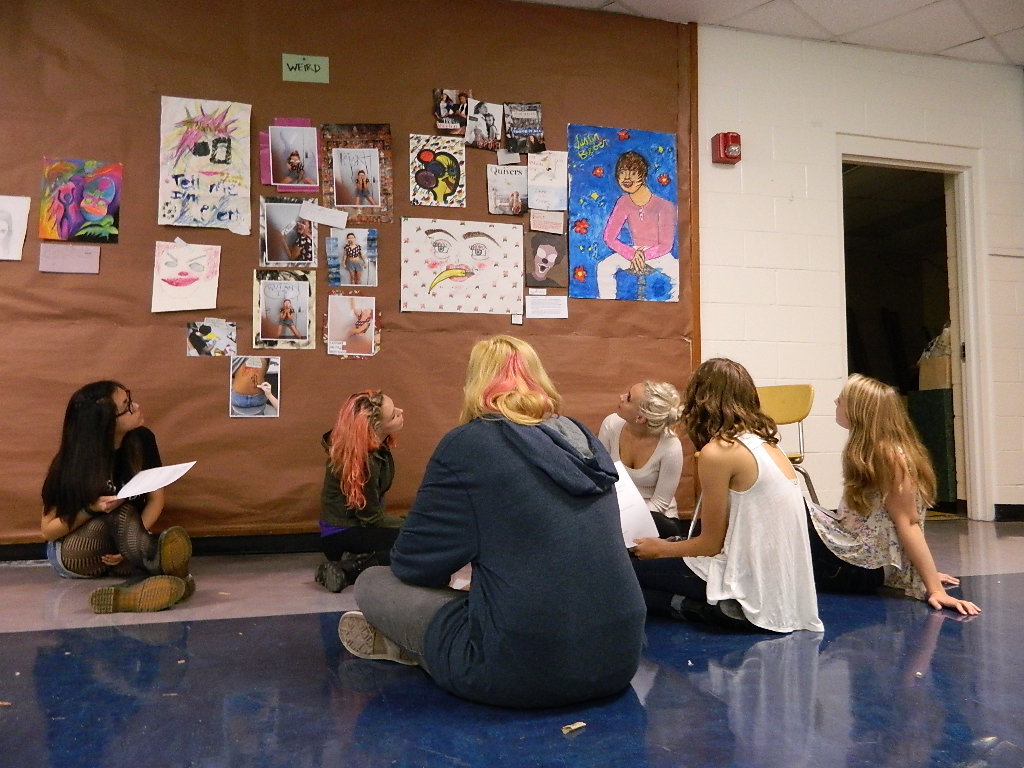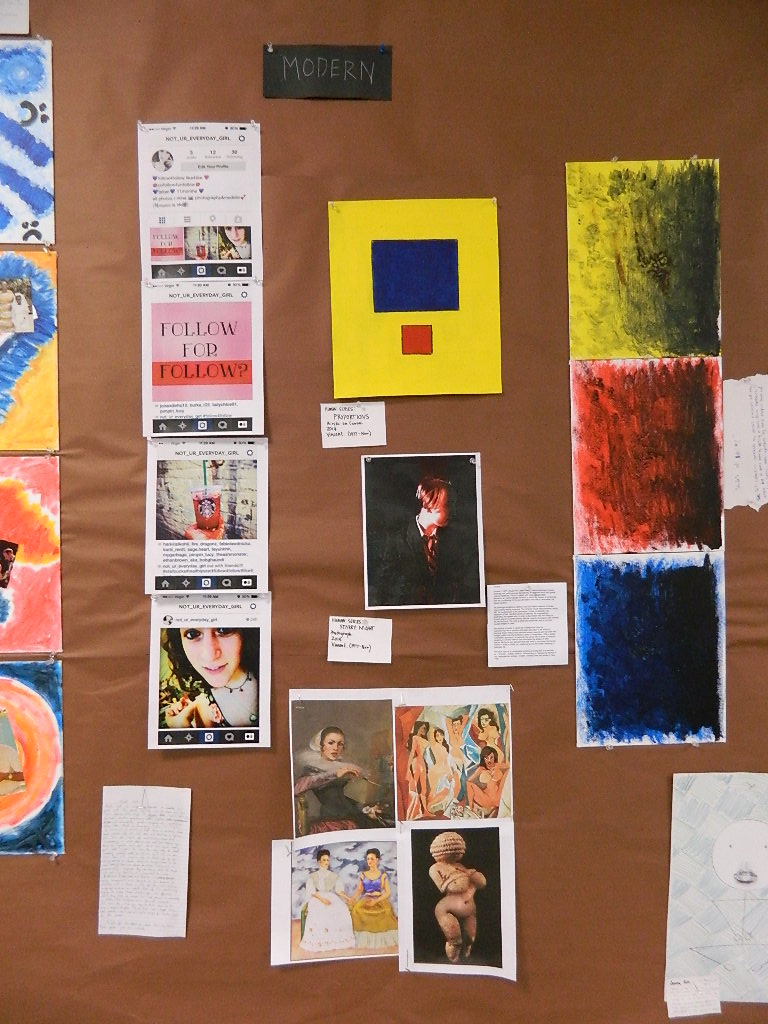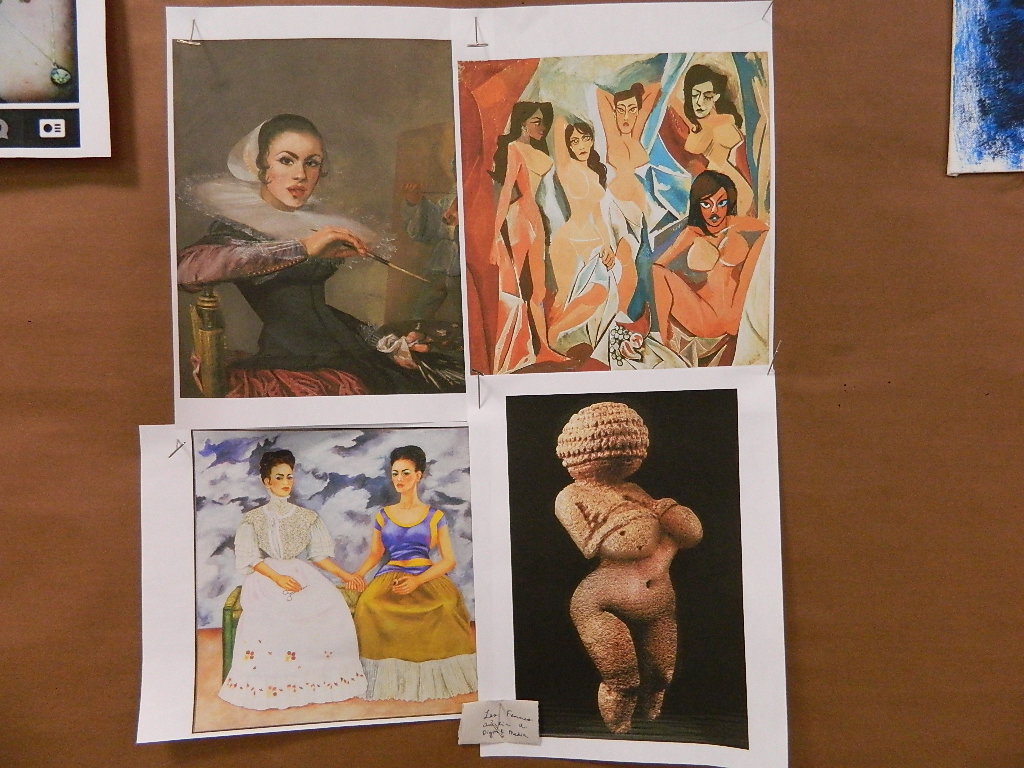
Students in Jack Watson’s advanced art class discuss works in the Weird section of the ‘Bad Art’ exhibit. Courtesy of the author.
How can we encourage students to take risks and to fail?
How can students define their aesthetic and also shed the habits that limit their choices?
How can we create a culture for collaboration and play in the classroom?
In this creativity exercise, students will make some really bad art. Not only will they make it, but they will curate and install a show of their failures. Adapted from the work of educator Mira Schor, the goal of this exercise is to allow students to experiment and fail without fear of grade consequences, while also defining the student’s aesthetic by what it isn’t. I like to do this at the very beginning of the year with a group of advanced students, but it could be done at any level at any time. The exercise becomes collaborative and playful, and sets the tone for the year to come—that the art classroom is a space of experimentation and creative risk. It also helps students shed some of the habits that begin to form as they work through a high school art program.
Discuss aesthetics: The unit begins with a conversation about the kind of artwork we find most meaningful or beautiful. I ask students to share examples of their favorite artworks, or describe the kinds of artworks they love to make. Students will be eager to share their opinions or bond with peers over a shared interest, especially at the beginning of the year. Then, I give them the following prompt: “Your task with this unit is to make bad art—make something that would be the opposite of what you just described.” At this point, students have no problem articulating their negative aesthetic and the discussions become considerably more animated.
Make bad art: I then turn students loose in the studio with a limited time frame. They must complete their works (or series of works) in one week. Students dive right in, often taking on multiple projects because they keep thinking of ways to make bad art. Before long, themes start to emerge in their work. You will have students who make work that is deliberately sloppy (bad = poorly executed), overly conceptual (bad = pretentious), disturbing or grotesque (bad = ugly), or minimalistic (bad = simple). Then, students write artist statements to accompany their work.
Curate a show: At the end of the week, students shift their roles from artists to curators. Looking at everything they produced, they collectively organize their work into categories based on the themes that emerged. They will then prepare and hang a show of their bad art. They give the exhibition a title and someone writes a gallery statement introducing the collection to the viewer. We can then have a “gallery opening” which turns into a critique. Students separate into small groups according to their themes and have a discussion based on the following prompts:
- What “qualities” do these works share? What makes them bad? Why do they fail?
- What would make these “good”? Pick a work or two to talk about how they could be more successful.
- Pick a piece to defend and make an argument for it.
- What criteria do you use to evaluate art? What characteristics about an artwork determine if it’s “good” or “bad”?
- What does your work say about you, or about the artist you want to be? What part of this work is already in you?
In one version of this project, students produced a gallery show that they titled Through a Clown’s Eyes, and the sub-themes (or rooms in the gallery) included Weird, Primitive, Gestural and Minimal. During the critique (and in written reflections afterward) students talked about how it was sometimes awkward to make work outside their comfort zone, but how liberating it was to make work without fear of failure, or rather to fail on purpose. They enjoyed some of the pieces so much that many felt they ended up being “good” artworks after all. Without working under the strict self-governing habits that students impose on their work, they are free to experiment and take risks, letting go of their more mannered artistic identities.
One student writes: “I’m kind of freaking out because all of these works are successful in that they accomplish what the artist set out to do—if the artist intended to make bad art, and they met that goal, isn’t that then ‘good’ art? But then you kind of have to ask where the actual ‘art’ takes place—is it in the artist’s intention, the completion and presentation of the work, or the viewer’s reaction?”





